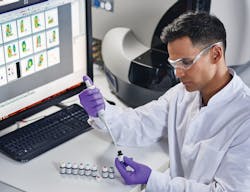Reproducibility in the clinical flow cytometry laboratory
In order to generate clinically relevant and reliable results, flow cytometry laboratories must ensure reproducibility across every aspect of testing. For some assays, labs may be able to use commercially available in vitro diagnostic (IVD) kits and some degree of automated preparation, analysis, and/or reporting, but the most complicated assays still rely largely on laboratory-developed tests (LDTs). Examples of these assays include evaluation of samples with known or suspected hematolymphoid malignancies and detailed immune monitoring. In order to achieve the required level of reproducibility, labs must consider a number of issues, including reagent quality, assay design, lab workflow and quality control.
Reagent quality: Insist on cGMP
Consistent results start with quality reagents. When designing a flow cytometry assay, emphasis is generally placed on antibody specificity and fluorophore, but reagent quality may not be initially considered even though it can be a source of inconsistency. For instance, CD3-FITC may vary among vendors in a number of respects, including protein yield, protein purification and fluorophore conjugation.
Tandem dyes, which rely on conjugation of two fluorophores to the antibody in such a way that energy transfer may occur between them, can further complicate manufacture of flow cytometry reagents. For instance, unless the manufacturing process is sufficiently robust, tandem fluorophores may yield varying signal strength and resolution and eventually degrade, with loss of the anticipated signal and introduction of errant signal in another fluorescent channel. Batch-to-batch variability in one or more of these may have an unanticipated impact on final results. Finally, if initial characterization to ensure that an antibody is indeed specific for the indicated antigen and does not bind to secondary off-target proteins is not conducted correctly by the vendor, users may have difficulty detecting issues on their own without robust controls.
The simplest means for a laboratory to source reagents that meet the criteria necessary for use in the clinical setting is to choose those that comply with current Good Manufacturing Practice or cGMP (21 CFR Part 820). In the United States, reagents labeled as Analyte Specific Reagents (ASRs)1 all meet cGMP criteria (21 CFR Part 820). Manufacturing processes are rigorously controlled, and the final product must meet clearly-defined standards.
Reagents labeled as IVD are similarly tightly controlled and regulated, but those labeled as Research Use Only (RUO)* are not regulated. Because cGMP (21 CFR Part 820) incurs additional work and expense, it is common for ASR- and RUO*-labeled products to be priced differently. The lower-priced reagents may be tempting, particularly in the increasingly constrained reimbursement climate facing clinical laboratories, but it’s important to realize that labs must then carry out the quality control steps that may not have been performed by the manufacturer. Using cGMP (21 CFR Part 820) reagents assures the user that lot-to-lot variability is minimized. It’s important to note, however, that an ASR label confers no analytic or performance characteristics—that’s up to the laboratory to establish when using these reagents to design and perform LDTs.2
Assay design
Probably the biggest challenge faced when designing a flow cytometry LDT, particularly one using 10 or more fluorescent parameters, is compensation; the process whereby signal from one fluorescence channel is adjusted to subtract undesired signal spilling into it due to spectral overlap among fluorophores. When possible, assays are designed in such a way that compensation is either minimal or is unlikely to affect the final results, due to the expected antigen expression patterns of the cells being studied.
Even when compensation is minimized, however, lot-to-lot variability in reagents, particularly in fluorophore conjugation and tandem dyes, can disrupt pre-determined compensation matrices and generate unexpected results. Establishing a new compensation matrix may be required in the event that a significant shift in fluorescence has occurred. However, this process requires time and technical resources that are in increasingly short supply in the clinical laboratory setting. Some vendors use proprietary methods to ensure lot-to-lot consistency of tandem dyes. For instance, one vendor “unfolds” the recipient dye, introduces the donor dye, and then refolds the recipient dye, thereby increasing the donor-to-receptor ratio in order to yield higher signal and better resolution, as well as greater tandem dye stability. This stability increases the user’s confidence that the reagent will perform as well on its expiration date as it did on the day it was first opened.
Laboratory workflow
The impact of laboratory workflow on the quality of the final results cannot be overstated. Even the best-designed assay may fall prey to inconsistencies in sample preparation, reagent storage and handling, and instrument settings and calibration. When feasible, every effort should be made to identify and mitigate sources of inconsistency and potential error in laboratory workflow. Opportunities include reagent storage and handling—the less pipetting the better, and shelf-stable pre-cocktailed formulations preferable to wet single-color reagents that require refrigeration. Antibody capture beads simplify the process of setting up compensation matrices, particularly when used together with suitable software.
Quality control
Historically, clinical flow cytometry laboratories have relied on a combination of normal and pathologic donor samples, cell lines and commercial controls with limited antigen range in order to assure accuracy and reproducibility. Ideal controls not only express all of the antigens usually studied but are suitable for use process controls, mimicking clinical samples as closely as possible while also being standardized and commercially available. By shifting some of the quality control burden to the vendor, the laboratory can focus on evaluating patient samples. Commercially available controls that meet these criteria are now available in the market.
Next steps
The last three decades have seen enormous growth in clinical flow cytometry testing and clinical impact, and growth is not expected to slow. We are now poised to make the next leap, moving away from LDTs and instead, leveraging standardized IVDs available to more laboratories that serve more patients. By addressing the quality control and reproducibility issues inherent in LDTs, particularly the challenges involved in comparing results from one LDT to those for another LDT, advances in technology and workflow can finally help labs make this leap.
*For research use only. Not for use in diagnostic procedures.
REFERENCES
1. FDA 21 CFR 864.4020
2. FDA Guidance Notes: Commercially Distributed Analyte Specific Reagents (ASRs) 2007.
About the Author

Jeannine T. Holden, MD
serves as Chief Medical Officer & Vice President, Scientific Affairs, Beckman Coulter. She currently serves as past president for the International Clinical Cytometry Society, ICCS, and is actively involved with both the International Society for the Advancement of Cytometry and the European Society for Clinical Cell Analysis.

